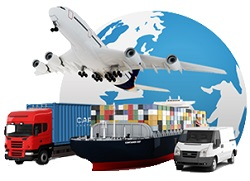Documentation Executive (1 years diploma)
Documentation Executive click here
Brief Job Description
Documentation Executives are also known as transportation assistants. Individuals in this role are
responsible for carrying out the paperwork required for dispatching outbound trucks and checking the
documents while receiving inbound trucks so that they comply with business and legal requirements.

Personal Attributes
This job requires the individual to work well with his/her team and achieve joint goals. The individual must
be able to prioritize and execute tasks within scheduled time limits. The individual should be able to
maintain high concentration levels throughout his/her shift.
Prepare for processing documents
Description
This unit is about preparing for processing documents
Elements and Performance Criteria
Obtain all the necessary information
To be competent, the user/individual on the job must be able to:
PC1. understand the work schedule for the day from the transport manager
PC2. obtain the list of inbound and outbound consignments, documentation checklists for inbound
and outbound transport from the transport manager
PC3. get details of the destination, route, weight of the load, type of truck, etc.
PC4. understand priorities (if any) among consignments.
Prepare computer and get required stationery
To be competent, the user/individual on the job must be able to:
PC5. switch on the computer and login using using company credentials.
PC6. check and ensure that the computer and the software are working well without any issues.
PC7. ensure there is sufficient stationery like paper, pens, government forms, etc
PC8. switch on printer, check ink levels in cartridge, refill/change if required and ensure that the
printer is in working condition.
PC9. have any issues/problems solved before starting work.
Knowledge and Understanding (KU)
The individual on the job needs to know and understand:
KU1. knowledge of organizational products and procedures
KU2. procedures for dealing with loss or damage to goods
KU3. risk and impact of not following defined procedures/work instructions
KU4. knowledge of computer systems used for documentation in the organization
KU5. knowledge of all relevant safety and security procedures
KU6. knowledge of standard operating procedures (sops) and how to react in emergencies.
KU7. knowledge of how to prepare the required documents and the number of copies needed
KU8. knowledge of transport companies the organization works with and their processes
KU9. knowledge of processes involved in inbound and outbound transport
KU10. knowledge of legal requirements, rules and regulations to be followed while preparing forms
and documents
KU11. knowledge of each form required for inbound/outbound transport.
KU12. knowledge of details to be filled into each form.
KU13. knowledge to use the computer for electronic documentation
KU14. types of workplace hazards that one can encounter on the job and safe operating practices
KU15. knowledge of possible difficulties in documentation
Generic Skills (GS)
User/individual on the job needs to know how to:
GS1. note down details regarding documentation for each inbound and outbound consignment
GS2. fill out forms, inspection checklists for inbound and outbound consignments.
GS3. prepare detailed reports for management
GS4. read and follow instructions in the checklists
GS5. read and understand details required in the forms
GS6. communicate clearly with managers and peers
GS7. regularly communicate with all employees to ensure activities are running smoothly
GS8. provide advice and guidance to peers and juniors
GS9. act objectively , rather than impulsively or emotionally when faced with difficult/stressful or
emotional situations
GS10. adjust according to volume, capacity and manpower needs during peak and non-peak hours
GS11. prioritize and execute tasks within the scheduled time limits
GS12. maintain schedules and punctuality. avoid absenteeism.
GS13. be a team player and achieve joint goals
GS14. flexibility to re-assess schedule in case of delays/additional orders
GS15. understand the customer requirements and ensure that they are met
GS16. identify trends/common causes for errors and suggest possible solutions to the transport
manager
GS17. help resolve any documentation issues faced by the truck drivers en route.
GS18. handle day to day problems like delays, staffing shortage, etc.
GS19. suggest methods to streamline the documentation process.
GS20. ability to check that all the forms required in the checklist have been filled out and are ready
GS21. ability to concentrate on task at hand and complete it without errors
Perform documentation of inbound and outbound consignments
Description
This OS unit is about performing documentation of consignments
Elements and Performance Criteria
Prepare documents for outbound consignments

To be competent, the user/individual on the job must be able to:
PC1. prepare 5 copies of the lorry receipt (LR) or goods consignment (GC) note after receiving the
customer order to be distributed as per company policy
PC2. based on the information contained in the lr, update details regarding the load and the
destination into the computer.
PC3. combine different loads onto a truck for transshipment based on common destination and
the truck’s maximum load capacity
PC4. prepare an agreement sheet to be given at the destination along with the consignment
PC5. fill out transit insurance forms and any octroi/tax permits for each truck.
PC6. check the permits to ensure that they are current and that the truck could travel through the
route to its destination.
PC7. verify that all the required forms have been filled out and tick off the documents as per the
outbound documentation checklist.
PC8. confirm with the dispatcher that the truck’s destination and goods loaded have been verified
PC9. brief the truck driver on the end customer, destination, proposed route, transport
regulations, formalities at check posts. handover the cash and required documents to him in
order to begin the journey.
PC10. get the truck driver’s signature on a form (and all other forms as required), confirming that
the goods, cash for the journey and all the documents needed for the journey have been
received.
Receive and verify documents for inbound consignments
To be competent, the user/individual on the job must be able to:
PC11. receive the signed agreement sheet for the inbound consignment from the receiving
assistant
PC12. prepare an arrival report based on the agreement sheet.
PC13. receive accounts of the journey from the driver and prepare the cost sheets.
PC14. collect and verify all the documents such as insurance forms, octroi/tax forms from the
inbound trucks.
PC15. verify that all the required forms have been received/filled out and documents checked as
per the inbound documentation checklist.
PC16. check that the truck has been unloaded and goods are in good condition.
PC17. prepare the goods received document, get it signed by the concerned authorities and hand it
over to the driver.
PC18. get the truck driver’s signature on a form (and all other forms as required), confirming that
the cash for the return journey and all the documents needed for the journey have been
received.
PC19. receive damage claim forms, forms for replacement of goods, etc. from the receiving
assistant, verify and send them to the concerned person/company for processing.
PC20. using the information entered in the system by the receiving assistant, prepare the invoices
and send to accounts payable section.
Knowledge and Understanding (KU)
The individual on the job needs to know and understand:
KU1. knowledge of organizational products and procedures
KU2. procedures for dealing with loss or damage to goods
KU3. risk and impact of not following defined procedures/work instructions
KU4. knowledge of computer systems used for documentation in the organization.
KU5. knowledge of all relevant safety and security procedures
KU6. knowledge of standard operating procedures (sops) and how to react in emergencies.
KU7. knowledge of how to prepare the required documents and the number of copies needed
KU8. knowledge of transport companies the organization works with and their processes
KU9. knowledge of processes involved in inbound and outbound transport
KU10. knowledge of legal requirements, rules and regulations to be followed while preparing forms
and documents.
KU11. knowledge of each form required for inbound/outbound transport.
KU12. knowledge of details to be filled into each form.
KU13. knowledge to use the computer for electronic documentation
KU14. types of workplace hazards that one can encounter on the job and safe operating practices.
KU15. knowledge of possible difficulties in documentation.
Generic Skills (GS)
User/individual on the job needs to know how to:
GS1. note down details regarding inspection of each inbound consignment.
GS2. fill out forms, inspection checklists pertaining to the inbound consignments.
GS3. prepare detailed reports for management.
GS4. read and follow instructions in the checklists
GS5. read and understand details required in the forms.
GS6. communicate clearly with managers and peers
GS7. regularly communicate with all employees to ensure activities are running smoothly
GS8. provide advice and guidance to peers and juniors
GS9. act objectively , rather than impulsively or emotionally when faced with difficult/stressful or
emotional situations
GS10. adjust according to volume, capacity and manpower needs during peak and non-peak hours
GS11. prioritize and execute tasks within the scheduled time limits
GS12. maintain schedules and punctuality. avoid absenteeism.
GS13. be a team player and achieve joint goals
GS14. flexibility to re-assess schedule in case of delays/additional orders
GS15. understand the customer requirements and ensure that they are met.
GS16. identify trends/common causes for errors and suggest possible solutions to the transport
manager.
GS17. help resolve any documentation issues faced by the truck drivers en route
GS18. handle day to day problems like delays, staffing shortage, etc.
GS19. suggest methods to streamline the documentation process.
GS20. ability to check that all the forms required in the checklist have been filled out and are
ready.
GS21. ability to concentrate on task at hand and complete it without errors
Complete post documentation activities
Description
This unit is about performing end of day activities.
Elements and Performance Criteria
Resolve documentation issues
To be competent, the user/individual on the job must be able to:
PC1. attend to calls from the driver if there are any documentation related issues at checkposts or
with police
PC2. understand the problem and explain to the driver how to handle the situation.
PC3. talk to the concerned authorities if required and resolve the issues
PC4. escalate to transport coordinator or transport manager if necessary.
Update details in the system and report to management
To be competent, the user/individual on the job must be able to:
PC5. note down details regarding the documentation prepared for each inbound and outbound
consignment

PC6. update all the details in the computer system.
PC7. inform the transport manager of any missed or delayed deliveries.
PC8. prepare reports on any documentation issues faced by trucks en route, delayed deliveries,
missed deliveries, etc.
Log off computer and clean up workspace
To be competent, the user/individual on the job must be able to:
PC9. save all data, safely log off and switch off the computer
PC10. dispose documentation which are no longer valid or not required
PC11. make sure that the computer is off, the work area is clean and ready for the next work day
Knowledge and Understanding (KU)
The individual on the job needs to know and understand:
KU1. knowledge of organizational products and procedures
KU2. procedures for dealing with loss or damage to goods
KU3. risk and impact of not following defined procedures/work instructions
KU4. knowledge of computer systems used for documentation in the organization.
KU5. knowledge of all relevant safety and security procedures
KU6. knowledge of standard operating procedures (SOPs) and how to react in emergencies
KU7. knowledge of how to prepare the required documents and the number of copies needed
KU8. knowledge of transport companies the organization works with and their processes
KU9. knowledge of processes involved in inbound and outbound transport.
KU10. knowledge of legal requirements, rules and regulations to be followed while preparing forms
and documents.
KU11. knowledge of each form required for inbound/outbound transport
KU12. knowledge of details to be filled into each form.
KU13. knowledge to use the computer for electronic documentation
KU14. types of workplace hazards that one can encounter on the job and safe operating practices
KU15. knowledge of possible difficulties in documentation.
Generic Skills (GS)
User/individual on the job needs to know how to:
GS1. note down details regarding inspection of each inbound consignment
GS2. fill out forms, inspection checklists pertaining to the inbound consignments.
GS3. prepare detailed reports for management.
GS4. read and follow instructions in the checklists
GS5. read and understand details required in the forms.
GS6. communicate clearly with managers and peers
GS7. regularly communicate with all employees to ensure activities are running smoothly
GS8. provide advice and guidance to peers and juniors
GS9. act objectively , rather than impulsively or emotionally when faced with difficult/stressful or
emotional situations
GS10. adjust according to volume, capacity and manpower needs during peak and non-peak hours
GS11. prioritize and execute tasks within the scheduled time limits
GS12. maintain schedules and punctuality. avoid absenteeism.
GS13. be a team player and achieve joint goals
GS14. flexibility to re-assess schedule in case of delays/additional orders
GS15. understand the customer requirements and ensure that they are met.
GS16. identify trends/common causes for errors and suggest possible solutions to the transport
manager
GS17. help resolve any documentation issues faced by the truck drivers en route.
GS18. handle day to day problems like delays, staffing shortage, etc.
GS19. suggest methods to streamline the documentation process
GS20. ability to check that all the forms required in the checklist have been filled out and are ready
GS21. ability to concentrate on task at hand and complete it without errors
Maintain Health, Safety and Security Measures during Documentation
Description
This unit is about health and safety measures
Elements and Performance Criteria
Maintain health, safety and security measures during all activities
To be competent, the user/individual on the job must be able to:
PC1. comply with safety regulations and procedures in case of fire hazards, biohazards, etc.
PC2. wear all safety equipment including protective gear, helmets etc. when checking
inbound/outbound consignments
PC3. follow organization procedures with respect to documentation.
PC4. recognize and report unsafe conditions and practices.
PC5. in case of signs of any emergency situation or accident or breach of safety immediately follow
organizational protocol to deploy action
PC6. identify reasons for occurrence of incident
PC7. capture reasons and response/action taken into incident report/note to manager
PC8. report any deviations from standard protocol along with reasons (if any)
PC9. visually inspect the activity area and equipment for appropriate and safe condition.

Knowledge and Understanding (KU)
The individual on the job needs to know and understand:
KU1. knowledge of organizational products and procedures
KU2. procedures for dealing with loss or damage to goods
KU3. risk and impact of not following defined procedures/work instructions
KU4. knowledge of computer systems used for documentation in the organization.
KU5. knowledge of all relevant safety and security procedures
KU6. knowledge of standard operating procedures (SOPs) and how to react in emergencies
KU7. knowledge of how to prepare the required documents and the number of copies needed
KU8. knowledge of transport companies the organization works with and their processes
KU9. knowledge of processes involved in inbound and outbound transport
KU10. knowledge of legal requirements, rules and regulations to be followed while preparing forms
and documents
KU11. knowledge of each form required for inbound/outbound transport.
KU12. knowledge of details to be filled into each form.
KU13. knowledge to use the computer for electronic documentation
KU14. types of workplace hazards that one can encounter on the job and safe operating practices.
KU15. knowledge of possible difficulties in documentation
Generic Skills (GS)
User/individual on the job needs to know how to:
GS1. note down details regarding documentation for each inbound and outbound consignment
GS2. fill out forms, inspection checklists for inbound and outbound consignments.
GS3. prepare detailed reports for management.
GS4. read and follow instructions in the checklists
GS5. read and understand details required in the forms.
GS6. communicate clearly with managers and peers
GS7. regularly communicate with all employees to ensure activities are running smoothly
GS8. provide advice and guidance to peers and juniors
GS9. act objectively , rather than impulsively or emotionally when faced with difficult/stressful or
emotional situations
GS10. adjust according to volume, capacity and manpower needs during peak and non-peak hours
GS11. prioritize and execute tasks within the scheduled time limits
GS12. maintain schedules and punctuality. avoid absenteeism.
GS13. be a team player and achieve joint goals
GS14. flexibility to re-assess schedule in case of delays/additional orders
GS15. understand the customer requirements and ensure that they are met.
GS16. identify trends/common causes for errors and suggest possible solutions to the transport
manager
GS17. help resolve any documentation issues faced by the truck drivers en route.
GS18. handle day to day problems like delays, staffing shortage, etc
GS19. suggest methods to streamline the documentation process.
GS20. ability to check that all the forms required in the checklist have been filled out and are
ready.
GS21. ability to concentrate on task at hand and complete it without errors
Employability Skills (60 Hours)
Description
This unit is about employability skills, Constitutional values, becoming a professional in the 21st Century,
digital, financial, and legal literacy, diversity and Inclusion, English and communication skills, customer
service, entrepreneurship, and apprenticeship, getting ready for jobs and career development.
Scope
The scope covers the following :
Introduction to Employability Skills
Constitutional values – Citizenship
Becoming a Professional in the 21st Century
Basic English Skills
Career Development & Goal Setting
Communication Skills
Diversity & Inclusion
Financial and Legal Literacy
Essential Digital Skills
Entrepreneurship
Customer Service
Getting ready for Apprenticeship & Jobs
Elements and Performance Criteria
Introduction to Employability Skills
To be competent, the user/individual on the job must be able to:
PC1. identify employability skills required for jobs in various industries
PC2. identify and explore learning and employability portals
Constitutional values – Citizenship
To be competent, the user/individual on the job must be able to:
PC3. recognize the significance of constitutional values, including civic rights and duties,
citizenship, responsibility towards society etc. and personal values and ethics such as
honesty, integrity, caring and respecting others, etc.
PC4. follow environmentally sustainable practices
Becoming a Professional in the 21st Century
To be competent, the user/individual on the job must be able to:
PC5. recognize the significance of 21st Century Skills for employment
PC6. practice the 21st Century Skills such as Self-Awareness, Behaviour Skills, time management,
critical and adaptive thinking, problem-solving, creative thinking, social and cultural
awareness, emotional awareness, learning to learn for continuous learning etc. in personal
and professional life
Basic English Skills
To be competent, the user/individual on the job must be able to:
PC7. use basic English for everyday conversation in different contexts, in person and over the
telephone
PC8. read and understand routine information, notes, instructions, mails, letters etc. written in
English
PC9. write short messages, notes, letters, e-mails etc. in English
Career Development & Goal Setting
To be competent, the user/individual on the job must be able to:
PC10. understand the difference between job and career
PC11. prepare a career development plan with short- and long-term goals, based on aptitude
Communication Skills

To be competent, the user/individual on the job must be able to:
PC12. follow verbal and non-verbal communication etiquette and active listening techniques in
various settings
PC13. work collaboratively with others in a team
Diversity & Inclusion
To be competent, the user/individual on the job must be able to:
PC14. communicate and behave appropriately with all genders and PwD
PC15. escalate any issues related to sexual harassment at workplace according to POSH Act
Financial and Legal Literacy
To be competent, the user/individual on the job must be able to:
PC16. select financial institutions, products and services as per requirement
PC17. carry out offline and online financial transactions, safely and securely
PC18. identify common components of salary and compute income, expenses, taxes, investments
etc
PC19. identify relevant rights and laws and use legal aids to fight against legal exploitation
Essential Digital Skills
To be competent, the user/individual on the job must be able to:
PC20. operate digital devices and carry out basic internet operations securely and safely
PC21. use e- mail and social media platforms and virtual collaboration tools to work effectively
PC22. use basic features of word processor, spreadsheets, and presentations
Entrepreneurship
To be competent, the user/individual on the job must be able to:
PC23. identify different types of Entrepreneurship and Enterprises and assess opportunities for
potential business through research
PC24. develop a business plan and a work model, considering the 4Ps of Marketing Product, Price,
Place and Promotion
PC25. identify sources of funding, anticipate, and mitigate any financial/ legal hurdles for the
potential business opportunity
Customer Service
To be competent, the user/individual on the job must be able to:
PC26. identify different types of customers
PC27. identify and respond to customer requests and needs in a professional manner.
PC28. follow appropriate hygiene and grooming standards







